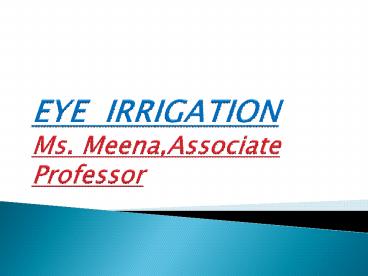Eye irrigation procedure - PowerPoint PPT Presentation
Title: Eye irrigation procedure
1
EYE IRRIGATIONMs. Meena,Associate Professor
2
- IRRIGATION
- cleaning a wound or body organ by
flushing or washing out with water or a medicated
solution.
3
EYE IRRIGATION
- Washing of the eye externally using stream of
water or other medicated fluids.
4
PURPOSES OF EYE IRRIGATION
- To clean the eye.
- To remove foreign particles , excessive
secretions or discharge. - To reduce inflammation , congestion and pain.
5
Cont
- To relieve discomfort.
- To apply medication for an antiseptic effect.
6
INDICATIONS
- Alkali or acid burns.
- Chemical irritants.
- To remove foreign bodies from the eye.
7
Cont
- Biohazard exposures.
- To prevent corneal and conjunctival scarring.
8
CONTRA-INDICATIONS
- Narrow anterior chamber angles.
- Head injury.
- Hypersensitivity to medications ( solutions
used in eye irrigation).
9
PRINCIPLES
- Comfort.
- Safety.
- Aseptic technique.
- Gentle handling.
10
ARTICLES
- ARTICLES
- A tray containing
- Eye irrigator ( undine) , a syring or plastic
bottle with the prescribed solution and I /v set
with attached tubing or a
- RATIONALE
- To irrigate the eye.
11
Cont
- sterile irrigating can with tubing or eye dropper.
12
Cont
- A bowel or jar with solution.
- Sterile wet swab in a bowl.
- To irrigate the eye.
- To clean the eye before the procedure.
13
(No Transcript)
14
(No Transcript)
15
Cont
- Sterile cotton balls in a container.
- A mackintosh and a towel.
- To dry the eye after procedure.
- To protect bedding and garments.
16
Cont
- Gloves.
- A kidney tray and paper bag.
- Eye medication if ordered
- To prevent cross infection.
- To receive the waste.
17
SOLUTIOS USED
- Plain water.
- Normal saline
- antiseptic , non- pyrogenic and
isotonic.
18
Cont
- Boric acid 2
- antiseptic , insecticide , flame retardant
and neutron absorber.
19
Cont
- Silver nitrate 1
- antiseptic , cauterizing agent and
disinfectant.
20
PROCEDURE
- STEPS OF PROCEDURE
- Explain the procedure to the patient and instruct
him to tilt his head toward the affected eye .
the patient may sit or lie in a supine position.
- RATIONALE
- To win the patient confidence and co-operation of
the client.
21
Cont
- Place the mackintosh and towel under the patient
head. - The kidney tray should be placed on the affected
side of the face.
- Protect the bedding and clothing.
- To prevent the bedding and clothes.
22
Cont
- Assemble articles at the bedside.
- Test the temperature of the irrigating solution.
- Facilitate orderly performance of procedure.
- The fluid should be at body temperature, if not
specified.
23
Cont
- Wash hands.
- Clean the eyelids and eyelashes using sterile wet
swabs.
- To prevent cross infection.
- Any crust on the eyelids and eyelashes should be
washed off before irrigation.
24
Cont
- Hold the eyelids open by separating the eyelids
gently with the thumb and forefingers. - Hold the filled eye irrigator about 2.5cm (
1inch) above the eye.
- If force is exerted on the eye , it can cause
spastic closure of the eyelids and will make
irrigation difficult. - Ensure safe pressure of the solution and avoids
possible injury to cornea.
25
Cont
- Allow irrigating fluids to flow from the inner
canthus to the outer canthus.
- To prevent forcing the infection to the
nasolacrimal duct.
26
cont
- Irrigate the eye until the solution leaving the
eye clear. - Repeat the procedure on the other side if
necessary.
- For proper cleaning of the eye.
- To avoid the spread of the infection from one eye
to the other.
27
AFTER CARE
- Dry around the eye and face with dry swab.
- Apply medication if ordered.
- Prevent infection and provide comfort.
- Aid is healing and prevent infection.
28
Cont
- Replace the articles.
- Record the procedure with date and time.
- Provide documentation for nursing action.
29
COMPLICATIONS
- Injury to soft tissues of the eyes.
- Superficial abrasion to cornea and conjunctiva.
30
Cont
- Infection to nasolacrimal duct.
- Burns.
31
NURSING RESPONSIBILITIES
- Check the name , bed number and identification of
the client. - Check the diagnosis and purpose of the eye
irrigation.
32
Cont
- Check the doctors orders for specific
instructions regarding type of the solutions ,
and the temperature . - Check the articles available in the patient unit.
33
Cont
- Assess the patient mental status to follow the
instructions. - Maintain aseptic technique .
34
Cont
- Record the amount of the fluid used.
- Instruct the client do not rub the eye for
sometime after the eye irrigation procedure.
35
Cont
- Inspect the eye after procedure if any
ulceration sign appear refer client to
physician. - If boric acid solution is used instruct client
not go to sunlight immediately.
36
- THANK YOU































